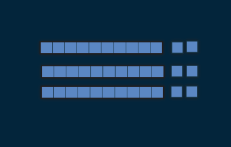A Troublesome Representation
In March I had the pleasure of attending a pre-conference workshop at the National Council of Teachers of Mathematics (NCTM) Conference in Indianapolis with Karen Karp and Barb Dougherty. These ladies are dynamic and engaging presenters with a wealth of knowledge to share. At one point Karen showed a slide with a representation that a student made out of blocks. The group gasped at the image and I remember thinking, “Wow! That student clearly has not had enough opportunities for conceptual understanding! I wonder if the teacher(s) went right to the standard algorithm without exploring what multiplication actually is.”
I was tutoring an on-level 4th grader about a month later. My own son was in 5th grade at the time so I had them work together on an activity. I gave them this word problem from https://www.mathworksheets4kids.com/:
Joy made 3 trips to the candy store. For every trip she made, she bought 12 packs of orange candies. How many packs of candies did Joy buy in total?
I put out base ten blocks and asked the two boys to come up with a representation for the story. I said that I did not need an answer, just a visual of what was happening in the story. To my great astonishment after a few minutes this is what they came up with…
In my head I was expecting 3 groups of 12 blocks or 3 rows of 12 to make a large array. I was absolutely not expecting them to make an equation out of the base ten blocks. This astonishing representation that was in the pre-conference workshop as a cautionary tale came to life in my own tutoring session - with my own son! I asked the boys to explain and they told me that it shows three times twelve equals thirty six. I was actually so blown away I didn’t know where to start.
I ended up starting with the meaning of the equal sign. Upon review the boys were able to articulate that the equal means “the same as.” I said, “If equals means the same as, shouldn’t there be the same amount of blocks on both sides of the equal sign?” I was hoping this would get them to adjust the representation. Do you know what they did next? With my son’s prompting they continued to add blocks to the multiplication sign to make it larger to account for the missing blocks. 🤯 Seriously! We continued to discuss and work together until they came up with an array that resembles this mock up I made with Didax Virtual Manipulatives.
Key Takeaway
Try giving your students a word problem like this in the first weeks of school (multiplication for 4th grade and up, addition for 3rd grade and below). Be sure not to give them too much since we’re looking for exploration and productive struggle. Simply ask them to use the resources (or draw) to come up with a visual representation for what is happening in the story. Too often students barely read the story and go right for an operation. “This is multiplication so let’s just make a multiplication problem!” You’ll have an idea of who is stuck on the algorithm, who has deeper conceptual understanding, and who is reading to find out what is actually happening in the story. If you want to try the same problem I gave, you can grab it off of the free sample worksheet. The beginning of the year is a great time to explore student thinking to help guide instruction.


